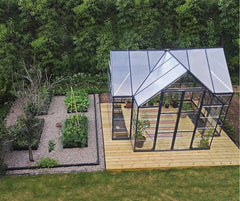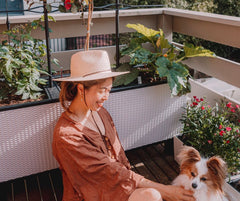
Troubleshooting Your Maze Compost Tumbler: Smells, Pests & More
Composting is one of the most rewarding ways to turn food scraps and garden waste into rich, garden-boosting compost - but let’s be honest, even the best Maze compost tumbler can sometimes hit a bump in the road.
From unwanted odours and curious critters to stubborn clumps that refuse to break down, every composter faces a hiccup or two.
If you’ve run into trouble with your Maze compost tumbler, don’t throw in the trowel just yet. We’re here to break down the most common issues, answer your top compost questions, and help you get back on track with easy, effective fixes. Let’s dive in.
Why Does My Compost Tumbler Smell Bad?
A healthy compost tumbler should have an earthy, pleasant aroma - not a pong that makes you run for the hills. If your Maze compost tumbler smells off, there’s usually a simple reason behind it.
The Usual Suspects
-
Too Many “Greens”: If your compost is loaded with food scraps, grass clippings, or other wet materials and not enough dry stuff, you’ll end up with a soggy, smelly mess.
-
Lack of Airflow: Compost needs to breathe. If your tumbler hasn’t been turned regularly, it may go anaerobic (without oxygen) and start to stink.
-
Excess Moisture: A dripping wet compost tumbler creates the perfect environment for bad bacteria and odours.
How to Fix Compost Tumbler Smells
-
Balance the Mix: Aim for a ratio of about 2 parts “browns” (dry leaves, shredded paper, straw) to 1 part “greens” (kitchen scraps, fresh lawn clippings).
-
Turn Often: Rotate your Maze tumbler at least every couple of days to keep air flowing and prevent compacting.
-
Soak Up Excess Moisture: Add more browns to absorb extra liquid, especially if you’ve recently added a lot of wet food scraps. Sugar cane mulch is a great option and very absorbent.
If your compost still smells after adjusting, check for any non-compostable items (meat, dairy, oily foods) that may have snuck in. Remove them and rebalance your mix.
How Do I Get Rid of Flies or Pests in My Compost Tumbler?
Compost is meant to attract microbes and worms - not swarms of flies or armies of ants. Still, if you spot pests in your Maze compost tumbler, it’s usually a sign your compost buffet is a bit too inviting. (we need to change that)
Common Compost Pests and Why They Show Up
-
Fruit Flies: Attracted by exposed food scraps, especially if the compost is too wet or not covered by browns.
-
Ants: Often appear if the compost is too dry or if you’re composting near ant nests.
-
Rodents: VERY Rare in sealed tumblers, but possible if the lid isn’t secured or if inappropriate food scraps are added.
How to Stop Compost Pests
-
Cover All Food Scraps: Every time you add kitchen scraps, top it off with a generous layer of browns. This hides odours and makes your tumbler less appealing to flies.
-
Maintain Proper Moisture: If you notice ants, wet your compost to keep it damp (like a wrung-out sponge) but not soaked.
-
Sliding Doors Closed: Always ensure the tumbler is sealed properly after each use.
-
No Meat, Dairy, or Oils: These attract pests fast. Stick to fruit, veg, coffee grounds, egg shells and garden clippings.
Why Isn’t My Compost Breaking Down Properly?
Patience is part of the process, but if your Maze compost tumbler seems to be taking forever, something’s not quite right.
What’s Slowing Things Down?
-
Wrong Mix of Materials: Too many browns can slow composting, just as too many greens can cause a slimy, smelly pile.
-
Not Enough Turning: Compost breaks down faster with oxygen. Turn your tumbler every 2–3 days for best results.
-
Large or Tough Items: Big chunks of veggie scraps, corn cobs, or branches take longer. Chop materials smaller before adding them in.
-
Cold Weather: Compost slows down in winter, but you can help by keeping your tumbler in a sunny spot and turning it regularly.
Quick Tips to Speed Things Up
-
Chop Before You Drop: Smaller pieces break down much faster.
-
Keep It Moist: If it looks dry, add water until it’s damp but not dripping.
-
Regular Turning: Keep air circulating and distribute heat by rotating often.
-
Feed It Well: A balanced diet of greens and browns keeps microbes happy and hungry.

Best Composting Practices for Healthy, Trouble-Free Compost
If you want a thriving, low-fuss compost tumbler, stick to these Maze-approved basics:
-
Always add a handful of browns after every batch of kitchen scraps
-
Turn regularly - consistency is key
-
Monitor moisture: not too dry, not too wet
-
Avoid composting meats, dairy, oils, and pet waste
-
Place your tumbler in partial sun to help it heat up without drying out too fast
FAQs
1. Why does my compost tumbler smell bad?
Usually, it’s because of too many greens, not enough browns, or excess moisture. Fix it by rebalancing your mix, adding dry materials, and turning more often.
2. How do I get rid of flies or pests in my compost tumbler?
Cover food scraps with browns, keep your compost moist but not wet, always close the lid tightly, and never compost meat, dairy, or oily foods.
3. Why isn’t my compost breaking down properly?
Make sure you’re turning the tumbler regularly, keeping the moisture balanced, and using a good mix of chopped-up greens and browns. Cold weather may also slow things down.
Need a refresher on what’s compostable and what’s not? Read More
Check out our full Maze compost bin range





